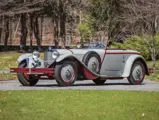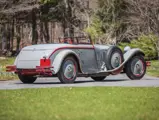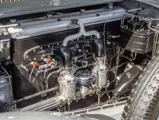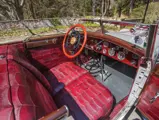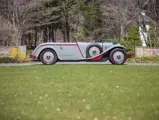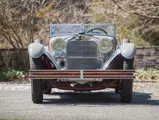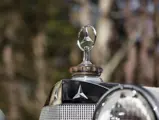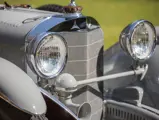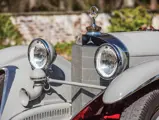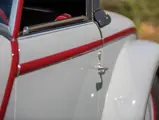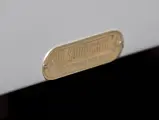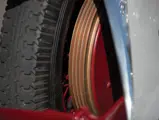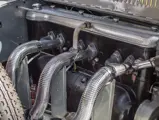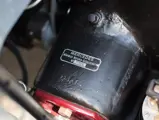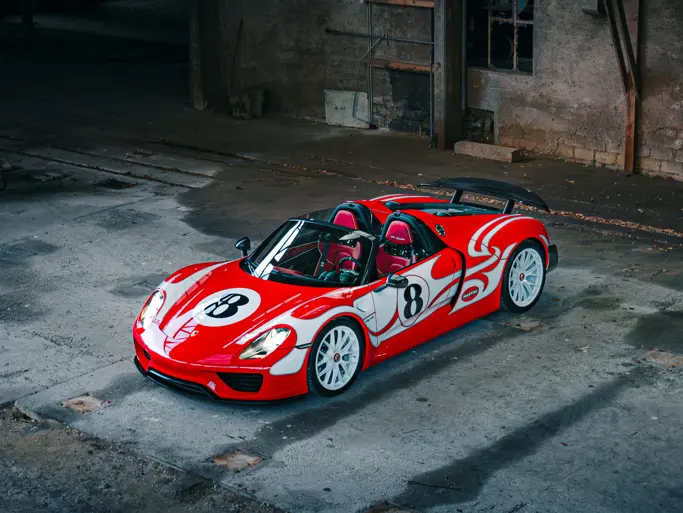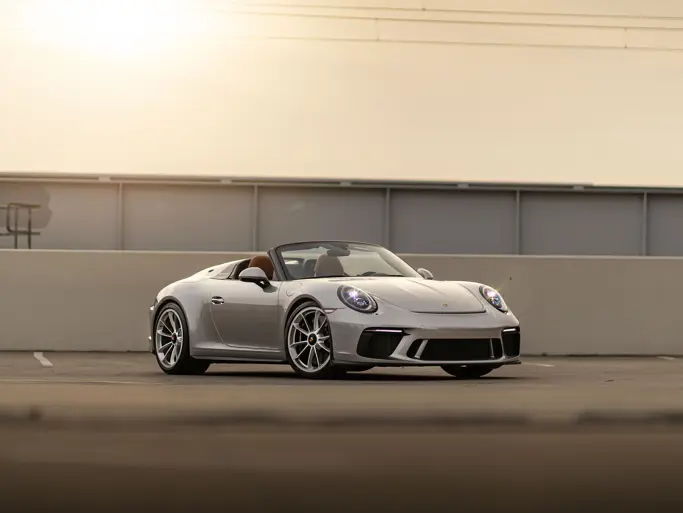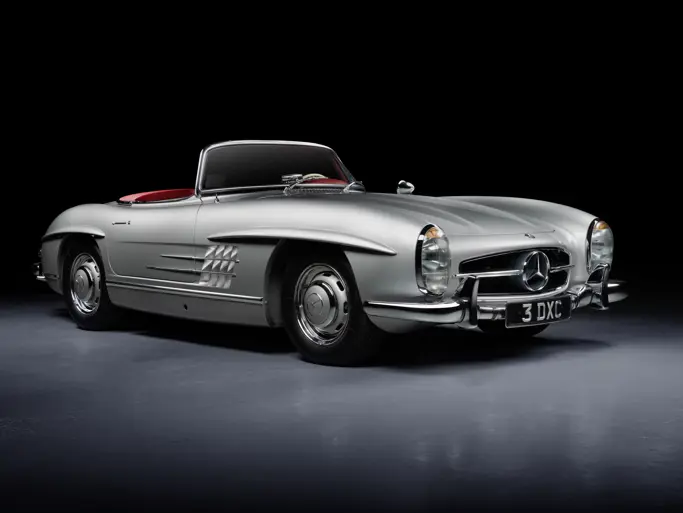Villa Erba 2017
1928 Mercedes-Benz 680 S Torpedo-Sport Avant-Garde by Saoutchik
{{lr.item.text}}
€6,500,000 - €8,000,000 EUR | Not Sold
 | Cernobbio, Italy
| Cernobbio, Italy
{{internetCurrentBid}}
{{internetTimeLeft}}

- Best of Show, 2012 Pebble Beach Concours d’Elegance
- First in Class, 2013 Concorso d’Eleganza Villa d’Este
- The 1929 New York Auto Salon car; sole survivor of three short-windshield examples built
- Meticulous restoration by Paul Russell and Company
- One of the most significant Mercedes-Benz in the world
- Vincitrice del Best in Show al Concorso d’Eleganza di Pebble Beach nel 2012
- Vincitrice di Classe al Concorso d’Eleganza di Villa d’Este del 2013
- Esposta al Salone dell’Auto di New York del 1929; il solo sopravvissuto dei tre esemplari prodotti con il parabrezza basso
- Meticoloso restauro eseguito dalla Paul Russell and Company
- Una delle più significative Mercedes-Benz al mondo
In an era when the Ford Model T was selling one million units per year on average, there was an alternate world of exclusive automobiles. Born out of the age of custom horse-drawn coaches, it was one of high fashion and fine engineering. One in which the elite could custom order the car of their dreams with a bevy of fine materials, many of which were sourced from colonies around the world. Many of these cars would go on to be exhibited by their owners at famed concours d’ elegance. These events were not only a showcase for the automobiles, but also for the high fashion of the day.
THE MERCEDES-BENZ TYPE S
Germany’s post-World War I depression necessitated a merger between Daimler and Benz, a process that began in 1925 and was formally consummated on 26 June 1926; the joined companies’ product lines, manufacturing, and management were integrated and rationalized. Most importantly, the marques’ competition in racing ended, and the combined companies’ performance development efforts were placed squarely behind the Mercedes, resulting in some of the most exciting, famous, and successful automobiles ever built. The immediate result of the renewed focus and the concentration of the engineering talents of Dr Ferdinand Porsche, Hans Nibel, and Fritz Nallinger was the Mercedes-Benz Type S. Developed as a successor to the 6,246-cubic centimetre Model K, it was an automobile that would forever establish the credentials of Mercedes-Benz at the pinnacle of high-performance luxury automobiles. As the post-war recession faded, it was succeeded by an era of prosperity and a new social freedom, the Jazz Age. The Type S, developed as a successor to the Model K, was vigorous, powerful, vibrant, and purposeful. It became a signature of the times and the pinnacle of aspirations that, in the Roaring Twenties, seemed accessible to all.
Displacing 6,789 cubic centimetres, the all-new Type S engine had larger valves, dual carburettors, a modestly increased compression ratio, and a larger supercharger that delivered 7-psi boost when engaged. Rated 26/120/180 horsepower, the numbers denoting the engine’s taxable, naturally aspirated, and supercharged horsepower ratings, it owed little more than its single overhead camshaft and six cylinders to the earlier K and its predecessors. The design ingeniously deals with one of the major problems of 1920s automobiles, flexible chassis. For the S, the Mercedes team designed a ‘unit’ engine and transmission with rigid mounts, providing cross bracing and a jointed torque tube drive to the back axle. The massive powerplant contributed its own rigidity to the chassis structure, which was completely revised.
Fitted with streamlined, lightweight, two- and four-seat open coachwork from Sindelfingen and Europe’s finest coachbuilders, it was a sports car for select, successful owners who prized quality, flair, and performance above all else. It also was exclusive, with only 124 Type S and 114 Type SS built.
CARROSSERIE J. SAOUTCHIK
This 1928 Mercedes-Benz 680 S, complete with its low-slung torpedo roadster body by Carrosserie J. Saoutchik, of Paris, is a perfect example of coachbuilding of the late 1920s. It showcases some of the more exotic materials available to the coachbuilders of the day. The hides used to create the lizard skin interior were supplied by Alpina, a company that sourced products from the French colonies in Southeast Asia. The beautiful trim wood, known as Purpleheart, was also sourced out of the French colonies in South America.
The engineering of the Mercedes-Benz S chassis provided the perfect platform for Saoutchik’s rakish designs. Born Iakov Saoutchik in the Ukraine, he founded his eponymously named firm in 1906, in Neuilly-sur-Seine. A cabinetmaker by trade, he quickly found success as a custom coachbuilder. Establishing himself by creating stylish designs coupled with high-quality workmanship, he took many risks with design and materials. Nicknamed the ‘Viollet-le-Duc’, after a famously creative French architect, he was obsessed by form and often used brightwork appliqué to highlight the strong lines of his coachwork. His background as a cabinetmaker is evidenced in the tight tolerances and body panel fits that can be seen on his creations. One of his favoured design features, the disappearing top, provides an elegant and innovative solution to hide the convertible top.
CHASSIS NUMBER 35949
Chassis 35949 was delivered to Carrosserie J. Saoutchik in August 1928. Although the original commission papers note the client as Mr Charles Levine, it has always been said that it was his wife who actually placed the order. Ordered in Dove Grey, it sported a dark red lizard skin interior, a disappearing top, and striking German Silver trim on the fenders of its Torpedo-Sport body, which was described in period advertisements as ‘Avant-Garde’, a descriptor that certainly no one could argue with.
Mrs Levine was the wife of Charles A. Levine, who had made his fortune recycling World War I surplus brass and was, by 1927, a millionaire. Levine formed the Columbia Aircraft Company with Giuseppe Mario Bellanca and hired several pilots to attempt various publicity records to promote the company. The Orteig Prize was one, awarded to the first person to fly nonstop from New York to Paris. Levine, wanting to be a part of this historic flight, displaced the co-pilot in favour of himself. The co-pilot in turn sued Levine to have his spot reinstated. Levine was successful in keeping his spot on the plane, but the decision was made hours after Charles Lindbergh, in the Spirit of St Louis, had departed Roosevelt Field for his successful flight to Paris.
Levine then announced his intention to fly from America to Germany and carry a passenger. The pilot, Clarence Chamberlain, and Levine set off on 4 June 1927, on their flight to Berlin. They landed just 100 miles shy of their goal in a field at Eisieben, Germany. Levine continued various record attempts for years, until, after a series of bad investments, the federal government sued him for half a million dollars in back taxes.
Any one of these factors could have been the reason for the couple not taking delivery of their custom-built Mercedes at the showroom in New York City. Mercedes-Benz New York suddenly had a very expensive custom-ordered car in its showroom. They took the opportunity to use the car as a part of their display at the 1929 New York Auto Salon. It was also featured in their advertisement in the 1929 Auto Salon edition of Motor magazine.
BEDFORD FAMILY OWNERSHIP
Knowing that the Bedford family had previously purchased a Mercedes, the Sales department contacted the young Standard Oil director, Frederick Henry Bedford Jr., regarding the special car they had available. They made him an attractive offer, and so began a course that would bring him to the acquaintance of his future wife, Margaret Stewart.
According to her granddaughter, Muffie Murray, Margaret was dating an old family friend whom she found extremely boring. Margaret and the gentleman were attending a party in Ligonier, Pennsylvania, when she was introduced to Frederick Bedford. She told her granddaughter that she thought he was a lot of fun and a good dancer. When leaving the party, she spotted his car and ‘that was it.’ He offered to give her a ride back to Pittsburgh; ‘quite a racy proposition for a lady back then’, she would later tell Muffie. She accepted the ride, and although her old friend tried to keep up, he was no match for the ‘speed demon’ in the supercharged Mercedes-Benz. She recalled that they could see him fading behind in the distance. ‘After that’, she told her granddaughter, ‘there was no one else for me.’
Mr Bedford was a director of the Standard Oil Company for 25 years, and he was also president of the Atlas Supply Company, which sold tires, batteries, and other accessories. In 1947, as president of Atlas, he and other company executives made a business tour of 11 Central and South American countries in a DC-4 christened the Atlas Sky Merchant. It was specially fitted to display automotive and aviation accessories. In 1948, the group made a world flight, covering 50,000 miles in 100 days and visiting 26 countries, a tour which was recognized by the National Aeronautic Association as the first global merchandising flight.
Mr Bedford, who had made his home with Margaret in Greens Farms, Connecticut, suffered an untimely death while on a business trip in 1952, at the age of 61. Mrs Bedford was so heartbroken by her husband’s passing that she parked the 680 S in the garage and did not use it again.
In 1980, for her grandmother’s birthday, Muffie baked a cake in the shape of the car and also wrote a poem about it. Having grown up with the courtship story surrounding the Mercedes, she had always been fond of it. Mrs Bedford loved the Mercedes-shaped cake so much that she refused to cut it. She later surprised her granddaughter with the news that she was going to have the car restored for her, and a friend of the family was tasked with managing the restoration. Several shops were contacted to offer bids; one of these was Paul Russell’s Gullwing Service Company. When Russell inspected the car in Greens Farms, it still had its original lizard skin interior and license plates, which had been renewed for 1953 before Mr Bedford passed. Photographs taken during his inspection in 1980 would later provide valuable information to the current restoration team. During the restoration, which was awarded to Gus Reuter, the original lizard skin was changed to red leather and the wheel discs were omitted.
The car was exhibited at an AACA event in 1982, where it won a National First Prize. Mercedes-Benz then selected the car to be featured during its centennial celebrations in 1986. It was at these events that James S. Rockefeller, founding chairman of the Owls Head Transportation Museum in Maine, spotted the car. He was intrigued by the connection the car had to his family, the founders of Standard Oil. He asked for the loan of the car to the Owls Head Museum, and it would remain there as a prized exhibit for the next two decades.
After many years, the Bedford family decided to sell the car, and it was sold for only the second time in its life in 2006, with only 31,000 miles on its odometer. It was subsequently acquired in 2008 by the respected collectors Paul and Chris Andrews, of Texas.
The Andrews’ had an on-going relationship with Paul Russell and Company, and a final decision to commission a full restoration with the firm was made after Russell and his team presented a module on the challenges of restoring a coachbuilt car at the 2010 Symposium on Connoisseurship and the Collectible Car, sponsored by the Revs Institute and the Collier Collection, in Naples, Florida.
The car arrived at Russell’s Massachusetts facility in April of 2010, and its condition was thoroughly reviewed by the staff before a full frame-off restoration began. In-depth inspection and research revealed the impressive originality of the car. Having had single-family ownership for seven and a half decades ensured that very few parts of the car had ever been replaced. All chassis and drivetrain components are properly numbered internally and externally, matching the original commission papers.
The coachwork was remarkably sound, and the Saoutchik job number is stamped all over the original wood framing and metal fittings. Having been stored in such favourable conditions for so many years, the wood frame underneath the metal skin remained preserved, and only a few pieces in the top well had to be replaced.
The engine required a complete overhaul, but the gearbox and the rear end required only routine rebuilds, with both units disassembled and any internal parts replaced as necessary. The delicate engine turning was also restored and is exceptional in appearance. It is found in the most seemingly unlikely places, including the cylinder head, carburettors, and even a panel under the metal lid for the convertible top. That this ornate treatment would be applied to a component not openly visible is only one representative example of the engineering and artistry employed in the construction of this Mercedes-Benz. Vast effort was expended to restore and retain various parts that could have been more easily remanufactured. The original and slightly worn sill plates engraved ‘Carrosserie J. Saoutchik’ were painstakingly re-engraved rather than replaced. The same effort was put forth to retain the exquisite original exhaust side pipes, which were carefully cleaned and re-plated.
Accordingly, all of the craft specialists at Paul Russell and Company painstakingly researched every detail. This included a trip to Germany to analyse two remaining original Saoutchik lizard interiors, research for original Saoutchik photographs and family history, as well as sourcing 760 new lizard hides from Southeast Asia. The location that each piece was cut from was deliberately chosen in order to ensure that the finished upholstery panels displayed consistency of grain and colour tone.
The combination of the rich upholstery, lustrous nickel-plated hardware, and the glass-like finish of the wooden dash, door trim, and steering wheel results in a symphony of colour and texture.
Nothing but the best execution was acceptable in the appearance, operation, and presentation of the car. The supreme quality of the restoration was recognized at the 2012 Pebble Beach Concours d’Elegance, where the car was awarded 100 points before going on to claim the coveted Best of Show title. Additional accolades bestowed on the stunning Mercedes-Benz include Restoration of the Year at the 2012 International Historic Motoring Awards and First in Class at the celebrated 2013 Concorso d’Eleganza Villa d’Este on the shores of Lake Como, Italy.
Now presented as exhaustively researched as it is restored, it is today just as it appeared in the sparkle of the lights of the New York Auto Salon. It captures the spirit of youth and beauty that Margaret Stewart brought into the world of a man and his car. It embodies the emotion of an automobile that became an heirloom and the thrill of a long-sought victory. There are few words to describe the feeling—there is only one unforgettable, irreplaceable automobile.
In un'epoca in cui la Ford Model T si vendeva mediamente in un milione di pezzi all’anno, c'era un mondo diverso, fatto di automobili esclusive. Nato durante l’era delle carrozze trainate dai cavalli, era un mondo fatto di alta moda ed ingegneria raffinata, un luogo dove l'elite poteva ordinare l'auto dei sogni, personalizzandola con una miriade di materiali pregiati, molti dei quali venivano acquistati dalle colonie sparse in tutto il mondo. Molte di queste vetture sarebbero poi state esposte dai loro proprietari nei famosi concorsi d’eleganza, eventi che non erano solo una vetrina per le automobili, ma anche per l'alta moda del momento.
La Mercedes-Benz Tipo S
La depressione economica della Germania seguita alla fine della prima guerra mondiale ha reso necessaria una fusione tra la Daimler e la Benz, un processo che ha avuto inizio nel 1925 ed è stato formalmente concluso il 26 Giugno del 1926 quando le linee di assemblaggio e di produzione e la gestione, furono integrate e razionalizzate. Ancora più importante, terminò la concorrenza tra i due marchi nelle competizioni e, gli sforzi di sviluppo delle due società unite, furono affidati alla Mercedes, generando alcune delle automobili più emozionanti, famose e di successo mai costruite. Il risultato immediato della rinnovata strategia e la conseguente concentrazione dei talentuosi ingegneri dottor Ferdinand Porsche, Hans Nibel e Fritz Nallinger è stata la Mercedes-Benz Tipo S. Sviluppata come successore del Modello K con il motore da 6.246 cc, la S era un'automobile che avrebbe per sempre abbinato il nome Mercedes-Benz al vertice della produzione di automobili di lusso ad alte prestazioni. Non appena la recessione economica del dopoguerra si è attenuata, è stata sostituita da un periodo di prosperità e di una nuova libertà sociale e dalla musica Jazz. La Tipo S, sviluppata per succedere al modello K, era vigorosa, potente, vibrante e imponente. E 'diventata uno dei simboli dell’epoca al vertice delle aspirazioni che, nei ruggenti anni venti, sembravano alla portata di tutti.
Con una capacità di 6.789 centimetri cubici, il nuovo motore della Tipo S aveva valvole più grandi, doppi carburatori, un modesto aumento del rapporto di compressione ed un compressore più grande capace di generare, quando utilizzato, una sovrappressione di 0,5 bar. Il motore, chiamato 26/120/180 cavalli, con i numeri che denotano i cavalli fiscali, la potenza in modalità aspirata e quella in modalità sovralimentata, era completamente nuovo ed aveva il solo albero a camme in testa e la configurazione a 6 cilindri che potevano dirsi ripresi dal procedente motore Tipo K ed i suoi predecessori. Il design affrontava ingegnosamente uno dei maggiori problemi delle automobili negli anni ‘20, il telaio che fletteva. Sulla S, la squadra Mercedes ha progettato un motore indipendente ed una trasmissione su supporti rigidi, completata da bracci incrociati ed un albero di trsmissione tipo transalxle per trasmettere la potenza all’assale posteriore. Il massiccio propulsore contribuisce, così, alla rigidità della struttura del telaio, che è stato completamente rivisto.
Dotata di carrozzerie aperte, snelle, leggere, a due o quattro posti realizzate a Sindelfingen o dai migliori carrozzieri d'Europa, è stata una vettura sportiva per pochi, distinti proprietari, alla ricerca, soprattutto di qualità, intelligenza costruttiva e prestazioni in una vettura esclusiva, prodotta in 124 esemplari nel Tipo S e 114 esemplari nel Tipo SS.
CARROSSERIE J. SAOUTCHIK
Questa Mercedes-Benz 680 S del 1928, completa della sua carrozzeria aperta tipo torpedo ribassata realizzata dalla Carrosserie J. Saoutchik, di Parigi, è un perfetto esempio delle creazioni delle carrozzerie verso la fine degli anni ’20 del ‘900 e mostra l’impiego di alcuni dei materiali più esotici a disposizione dei carrozzieri del periodo. Le pelli utilizzate per creare l'interno, realizzato in pelle di lucertola, sono state fornite dalla Alpina, una società che commercializzava i prodotti in arrivo dalle colonie francesi nel Sudest asiatico. Il bel lavoro di ebanisteria degli interni è invece realizzato in legno della famiglia Peltogyne, l’Amaranto, anche lui proveniente dalle colonie francesi in Sud America.
La meccanica ed il telaio Mercedes-Benz S hanno fornito la piattaforma perfetta per i morbidi e dissoluti disegni di di Saoutchik. Nato in Ucraina, Iakov Saoutchik ha fondato la società che porta il suo nome nel 1906, a Neuilly-sur-Seine. Falegname di professione, ha rapidamente raggiunto il successo come carrozziere di vetture uniche. Per affermarsi come creatore di linee eleganti, accoppiate a lavorazioni di alta qualità, ha dovuto prendere dei rischi, sia dal punto dii vista stilistico, sia nella scelta dei materiali. Soprannominato il ‘Viollet-le-Duc’, dal famoso architetto e creativo francese, era ossessionato dalla forma ed ha usato spesso metalli lucidati per evidenziare le forti linee della sua carrozzeria. Il suo background come ebanista, è evidenziato nelle strette tolleranze e nei perfetti accoppiamenti dei pannelli della carrozzeria che si possono ammirare sulle sue creazioni. Uno dei tratti più riconoscibili del suo stile è il tetto apribile a scomparsa e, per farlo, ha creato un’elegante ed innovativa soluzione.
NUMERO DI TELAIO 35949
Il telaio 35949 è stato consegnato alla Carrosserie J. Saoutchik nel mese di Agosto del 1928. Sebbene i documenti ufficiali dell’ordine riportino come committente Mr Charles Levine, si è sempre detto che, in realtà, dietro la commessa ci fosse sua moglie. La carrozzeria Torpedo-Sport, descritta nella pubblicità d'epoca come 'd’avanguardia', caratteristica su cui nessuno ha mai neppure provato a discutere, è stata ordinata in color Tortora, con gli interni rivestiti in pelle di lucertola colore rosso scuro, un tetto in tela a scomparsa e, dei sorprendenti profili in alpacca sui parafanghi.
La signora Levine era la moglie di Charles A. Levine, che aveva fatto la sua fortuna dopo la prima guerra mondiale, riciclando l’ottone di risulta ed era, nel 1927, un milionario. Levine ha costituito la Columbia Aircraft Company assieme a Giuseppe Mario Bellanca e, per dare visibilità e promuovere l'azienda, aveva assunto diversi piloti per tentare vari record. L’ Orteig Prize era uno di questi, e sarebbe stato assegnato alla prima persona capace di volare non-stop da New York a Parigi. Levine, volendo essere parte integrante di questo volo storico, ha quindi appiedato il co-pilota a favore di se stesso. Il co-pilota ha, quindi citato in giudizio Levine per riottenere il suo posto. Levine ha vinto, ed ha mantenuto il suo posto in aereo, ma la decisione dei giudici è arrivata ore dopo che Charles Lindbergh, con il suo Spirit of St. Louis, era decollato dal Roosevelt Field per il suo volo, coronato da successo, verso Parigi.
Levine ha poi annunciato la sua intenzione di volare dall'America alla Germania, trasportando un passeggero. Il pilota, Clarence Chamberlain, e Levine partirono il 4 giugno 1927 sul loro volo per Berlino, atterrando poi in un campo a Eisieben, in Germania, ad appena 160 chilometri dal loro obiettivo. Levine ha continuato a provare di stabilire nuovi record per anni, fino a quando, a seguito di una serie di cattivi investimenti, il governo federale lo ha citato in giudizio per mezzo milione di dollari in tasse arretrate.
Uno qualsiasi di questi fattori potrebbe essere stata la ragione per cui la coppia non ha mai ritirato la loro Mercedes fuoriserie dallo showroom di New York City. La Mercedes-Benz di New York, in compenso, si è improvvisamente trovata con una costosa vettura, una fuoriserie realizzata su misura, nel suo negozio ed ha sfruttato l'opportunità, utilizzando l'auto come parte della loro esposizione al New York Auto Salon del 1929 e usandola per la loro pubblicità nella rivista Motor, nel numero dedicato allo stesso salone.
LA PROPRIETA' DELLA FAMIGLIA BEDFORD
Sapendo che la famiglia Bedford aveva precedentemente acquistato una Mercedes, il reparto vendite ha contattato il giovane direttore della Standard Oil, Frederick Henry Bedford Jr., per offrirgli l'auto speciale che avevano a disposizione. Gli hanno fatto un'offerta interessante e, così facendo, hanno iniziato un percorso che lo avrebbe portato a conoscere la sua futura moglie, Margaret Stewart.
Secondo quanto racconta la nipote, Muffie Murray, basandosi su quanto le ha raccontato la nonna, Margaret usciva con un vecchio amico di famiglia che trovava estremamente noioso. Margaret ed il suo cavaliere stavano partecipando ad una festa a Ligonier, Pennsylvania, quando è stata presentata a Frederick Bedford, che lei ha subito trovato molto divertente e buon ballerino. Al momento di lasciare la festa, lei ha notato la sua auto “ed è bastato”. Quando lui si è offerto di darle un passaggio per tornare a Pittsburgh, ‘una proposta piuttosto audace per una signora di allora’, avrebbe raccontato in seguito a Muffie, accettò il passaggio e, anche se il suo vecchio amico ha cercato di tenere il passo, non c’era stata gara con il ‘demonio della velocità’ e la sua Mercedes-Benz sovralimentata. Ricordava ancora come lo avessero visto sparire in lontananza, mentre si allontanavano, ‘dopo di che’, ha detto alla nipote, ‘ai miei occhi non c'era più nessun altro.’
Mr Bedford è stato il direttore della Standard Oil Company per 25 anni, ed è stato anche presidente della Atlas Supply Company, che vendeva pneumatici, batterie e altri accessori. Nel 1947, come presidente della Atlas, lui e altri dirigenti della società avevano fatto un giro d'affari in 11 paesi del Centro e del Sud America in un DC-4 battezzato “il Mercantile del Cielo della Atlas”, che era stato appositamente preparato per mostrare gli accessori automobilistici e aeronautici. Nel 1948, il gruppo ha fatto un volo intorno al mondo, coprendo 50.000 miglia in 100 giorni e visitando 26 paesi, in un tour che è stato riconosciuto dal National Aeronautic Association come il primo volo mondiale di promozione commerciale.
Mr Bedford, che aveva stabilito la sua residenza con Margaret, a Greens Farms, nel Connecticut, è prematuramente scomparso all’età di 61 anni, nel 1952, durante un viaggio d'affari. La signora Bedford, con il cuore spezzato dalla scomparsa dell’adorato marito, ha parcheggiato la 680 S in garage e non l’ha più utilizzata.
Nel 1980, per il compleanno di sua nonna, Muffie prepara una torta con la forma della macchina e scrive una poesia su di lei. E’ cresciuta ascoltando il racconto della storia del corteggiamento che coinvolge la Mercedes, e se ne era inamorata. La signora Bedford ha apprezzato così tanto la torta a forma di Mercedes, che si è rifiutata di tagliarla. In seguito, Margaret sorprende la nipote con la notizia che stava per far restaurare la macchina per lei e, un amico di famiglia, viene incaricato di gestire il restauro. Diversi restauratori vennero contattati per preparare i preventivi e, tra questi, c’era Paul Russell, con la sua Gullwing Service Company. Quando Russell si è recato a Greens Farms per ispezionare l’auto, la Mercedes aveva ancora gli interni rivestiti con la sua pelle di lucertola originale e le sue targhe, rinnovate fino al 1953, prima della scomparsa del Sig. Bedford. Le fotografie scattate durante la sua ispezione nel 1980, si riveleranno poi preziose fonti di’nformazione per il suo team di tecnici che si è occupato dell’ultimo restauro. Durante il primo restauro, che è stato assegnato a Gus Reuter, la pelle di lucertola originale è stata sostituita con normale pelle rossa e, sono stati asportati i dischi di copertura delle ruote.
La vettura è stata quindi esposta ad un evento organizzato dall’AACA nel 1982, dove ha vinto il National First Prize. Mercedes-Benz ha poi selezionato l'auto tra quelle da utilizzare per le celebrazioni del suo centenario nel 1986 ed è stato in uno di questi eventi che James S. Rockefeller, presidente e fondatore dell’Owls Head Transportation Museum nel Maine, nota l’auto e si incuriosisce del collegamento che la macchina ha con la sua famiglia, fondatrice della Standard Oil. Ha quindi chiesto la macchina in prestito per poterla esporre all’Owls Head Museum, dove rimarrà, come uno dei pezzi più pregiati, per i succesivi due decenni.
Dopo tutti questi anni, la famiglia Bedford decide di vendere l'auto e, nel 2006, con solo 31 mila miglia sul suo contachilometri, la Mercedes viene offerta sul mercato. Nel 2008 viene acquistata dai rispettati collezionisti del Texas, Paul e Chris Andrews.
Gli Andrews hanno già lavorato con Paul Russell e la sua Paul Russell and Company che conoscono bene, ma, la decisione finale di commissionargli un restauro completo della macchina viene presa solo dopo che Russel con il suo gruppo di esperti ha illustrato, nel corso del Simposio sulla Conoscenza delle Vetture da Collezione, organizzato nel 2010 a Naples, Florida, e sponsorizzato dal Revs Institute e dalla Collier Collection, un documento sulle sfide che comporta il restauro delle auto allestite dai carrozzieri.
L'automobile arriva presso l’officina di Russell nel Massachusetts, nel mese di aprile del 2010, e le sue condizioni vengono accuratamente esaminate prima di dare inizio al restauro completo, che prevede anche il distacco della carrozzeria dal telaio. L’ispezione e la ricerca approfondita rivelano l’importante originalità della macchina, che, grazie alla proprietà di una sola famiglia durata oltre 75 anni, ha avuto pochissime parti sostituite. Tutti i componenti del telaio e della meccanica sono ancora numerate, sia all’interno sia all’esterno, con i codici corrispondenti a quelli originali, riportati sulla commessa. La carrozzeria era piacevolmente sana, ed il numero di lavoro di Saoutchik era ancora stampigliato su tutti i componenti in legno ed i particolari metallici. Essendo rimasta ferma per tanti anni, ricoverata in condizioni favorevoli, la struttura di legno sotto la pelle di metallo si era ben conservata, e solo pochi pezzi nella parte superiore hanno avuto bisogno di essere sostituiti.
Il motore ha avuto bisogno di una revisione completa ma, sia il cambio sia il retrotreno hanno avuto bisogno solo di qualche lavoro di manutenzione, con tutte le componenti smontate e le parti interne, solo dove necessario, rimpiazzate. Le delicate lavorazioni sul motore sono state a loro volta restaurate e sono tornate perfette alla vista anche se si trovano nei luoghi più apparentemente improbabili, tra cui la testa del cilindro, i carburatori, ed anche sotto il pannello metallico che fa da coperchio e chiude la capote. Che queste decorazioni siano applicate anche a componenti non apertamente visibili, è solo un esempio rappresentativo dell'ingegneria e dello stato dell’arte impiegato nella costruzione di questa Mercedes-Benz. Un grande sforzo è stato speso per ripristinare e riuscire a mantenere varie parti che avrebbero potuto essere, molto più facilmente, rimpiazzate. I battitacco montati sul lungherone sotto la portiera, leggermente usurati ma incisi con la scritta ‘Carrosserie J. Saoutchik’, sono stati accuratamente re-incisi anziché sostituiti. Lo stesso sforzo è stato profuso anche per riuscire a salvare i tubi di lato scarico originali e raffinati, che sono stati accuratamente puliti e ri-placcati.
In sintonia con quanto sopra, tutti gli specialisti della Paul Russell and Company hanno faticosamente ricercato ogni dettaglio. Ciò ha perfino incluso un viaggio in Germania per analizzare due interni di lucertola realizzati da Saoutchik e rimasti originali, la ricerca delle fotografie originali scattate da Saoutchik e la storia della sua famiglia, così come la ricerca di nuove 760 pelli di lucertola provenienti dal sud-est asiatico. La posizione che ogni singolo pezzo avrebbe poi avuto è stato attentamente scelta, al fine di garantire che i pannelli di rivestimento, una volta finiti, mostrassero consistenza nel colore e nella grana delle pelli.
La combinazione della ricca tappezzeria, dei brillanti particolari in acciao nichelato e la finitura vetrificata del cruscotto in legno, così come i rivestimenti delle porte ed il volante, creano una perfetta sinfonia di colori e materiali.
Nient'altro che il meglio nella sua esecuzione è stato, quindi, accettabile per l’apparenza generale, la funzionalità e la presentazione della vettura. L’altissima qualità dei lavori di restauro svolti è stata poi riconosciuta anche dai giudici del Pebble Beach Concours d’Elegance del 2012, dove la macchina ha ricevuto i 100 punti prima di essere acclamata come Best in Show.
Ulteriori riconoscimenti attribuiti a questa splendida Mercedes-Benz comprendono il premio Restauro dell'Anno all’International Historic Motoring Awards del 2012 e la vittoria di classse nel celebre Concorso d'Eleganza di Villa d'Este, sulle rive del Lago di Como, Italia, nel 2013.
Ora presentata come esaustivamente ricercata e restaurata in ogni dettaglio, si mostra oggi esattamente come quando ha fatto la sua comparsa nello scintillio delle luci del Salone dell’Auto di New York. Questa Mercedes incarna lo spirito della giovinezza e della bellezza che Margaret Stewart ha portato nel mondo di un uomo e della sua auto. Essa incarna l'emozione di un'automobile che è diventata un cimelio di famiglia ed il piacere generato da una vittoria a lungo cercata. Ci sono poche parole per descrivere queste sensazioni, c'è solo un’indimenticabile, insostituibile automobile.

